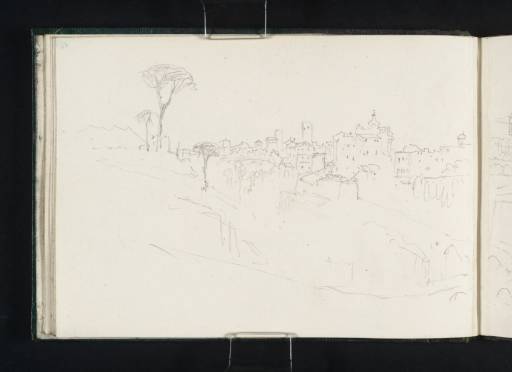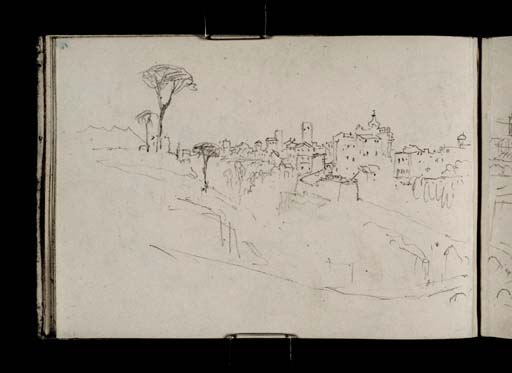Joseph Mallord William Turner Nepi, with the Aqueduct and Palazzo Comunale 1828
Image 1 of 2
Joseph Mallord William Turner,
Nepi, with the Aqueduct and Palazzo Comunale
1828
Folio 12 Verso:
Nepi, with the Aqueduct and Palazzo Comunale 1828
D21788
Turner Bequest CCXXXVI 12a
Turner Bequest CCXXXVI 12a
Pencil on white wove paper, 125 x 171 mm
Accepted by the nation as part of the Turner Bequest 1856
References
1909
A.J. Finberg, A Complete Inventory of the Drawings of the Turner Bequest, London 1909, vol.II, p.723, CCXXXVI 12a, as ‘A town’.
1984
Cecilia Powell, ‘Turner on Classic Ground: His Visits to Central and Southern Italy and Related Paintings and Drawings’, unpublished Ph.D thesis, Courtauld Institute of Art, University of London 1984, p.436.
This study marks the first appearance in the sketchbook of Nepi, a town in Viterbo which Turner encountered as he approached Rome. As the subject of a further twenty works in the present sketchbook, it appears more frequently than any other location: see between folios 12 verso and 30 recto (D21788–D21796, D21798, D21800–D21808, D21819–D21820).
As noted by the geographer and Turner researcher Roland Courtot, Nepi’s heightened appeal is largely explained by its dramatic topography: the town is perched high on a volcanic promontory, with a deep ravine to the north. As well as capturing the natural landscape, Turner also incorporated its monuments of religious, civic and military power, especially its cathedral, municipal palace, fortifications and aqueduct.1 As Cecilia Powell remarked, some sights became ‘almost an obsession with him, being sketched again and again, such as the aqueduct [...] memories of which were to occur in several of the composition studies in oils made in Rome later in the autumn’.2
Turner was already familiar with Nepi, having visited a decade earlier during his first major tour of Italy in 1819–20: see Nicola Moorby’s entries in the present catalogue for the Ancona to Rome sketchbook (Tate D14805, D14810, D14812–D14816; Turner Bequest CLXXVII 78, 80a, 81a–83a). On this earlier route to Rome, Turner approached Nepi from the north-east, taking in Spoleto, Terni, Narni and Civita Castellana. He charted a different route in 1828, approaching Nepi from the north-west via Viterbo, Caprarola and Ronciglione.
The present sketch is one such view of the town from the north-west. The sparsely detailed foreground is bordered with trees to the left and a stretch of the aqueduct to the right. Designed to resemble the aqueducts of Roman antiquity, it was constructed between the sixteenth and early eighteenth centuries, latterly under the direction of the architect Filippo Barigioni.3 On the horizon, to the right, is the distinctive pinnacle of the Palazzo Comunale, a municipal palace overlooking the Piazza del Comune in the heart of the old town. Commissioned while Nepi was under the rule of the Farnese dynasty, building works began under the architect Antonio da Sangallo the Younger in 1542 and concluded in 1744 under Michele Locatelli.4 Framing the view to the left are three stone pines, a species of tree that often appears in Turner’s sketches of Nepi, as observed by Courtot.5 The skyline terminates to the right with the dome and cupola of the Church of San Pietro. This vista continues onto folio 13 recto (D21789) opposite, a view that encompasses the Cathedral of Santa Maria Assunta.
Hannah Kaspar
December 2024
Roland Courtot, ‘12. Vers Rome: “Carnet de Viterbe et Ronciglione” (TB CCXXXVI)’, Carnets de voyage de Turner, accessed 15 July 2024, https://carnetswt.hypotheses.org/2312 .
Powell 1984, p.300. See also Martin Butlin and Evelyn Joll, The Paintings of J.M.W. Turner, revised ed., New Haven and London 1984, p.176, no.300, pl.303; p.177, no. 305, pl.308; p.178, no.312, pl.315.
‘The Aqueduct’, Museo Civico Nepi, accessed 31 July 2024, https://www.museociviconepi.it/en/monuments/the-aqueduct/ .
‘The City Hall’, Museo Civico Nepi, accessed 31 July 2024, https://www.museociviconepi.it/en/monuments/the-city-hall/ .
Roland Courtot, ‘12. Vers Rome: “Carnet de Viterbe et Ronciglione” (TB CCXXXVI)’, Carnets de voyage de Turner, accessed 15 July 2024, https://carnetswt.hypotheses.org/2312 .
How to cite
Hannah Kaspar, ‘Nepi, with the Aqueduct and Palazzo Comunale 1828’, catalogue entry, December 2024, in David Blayney Brown (ed.), J.M.W. Turner: Sketchbooks, Drawings and Watercolours, Tate Research Publication, February 2025, https://www


